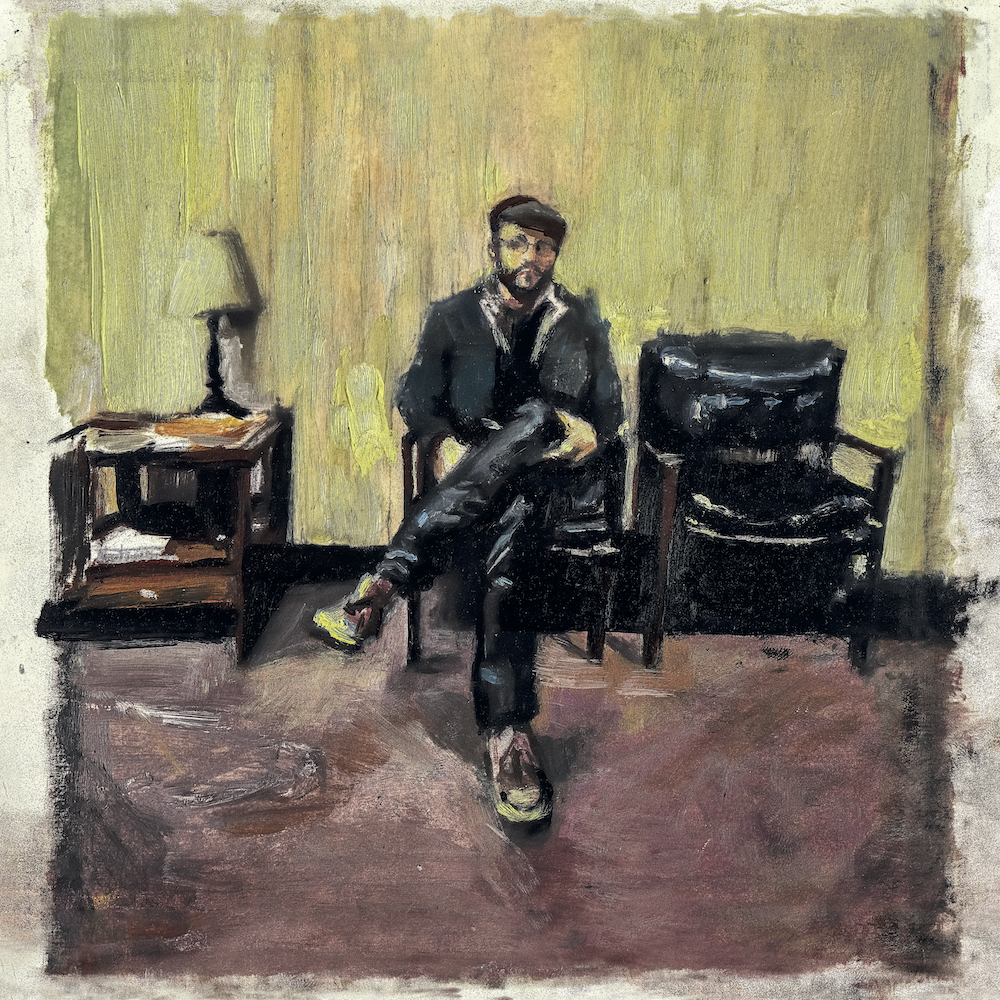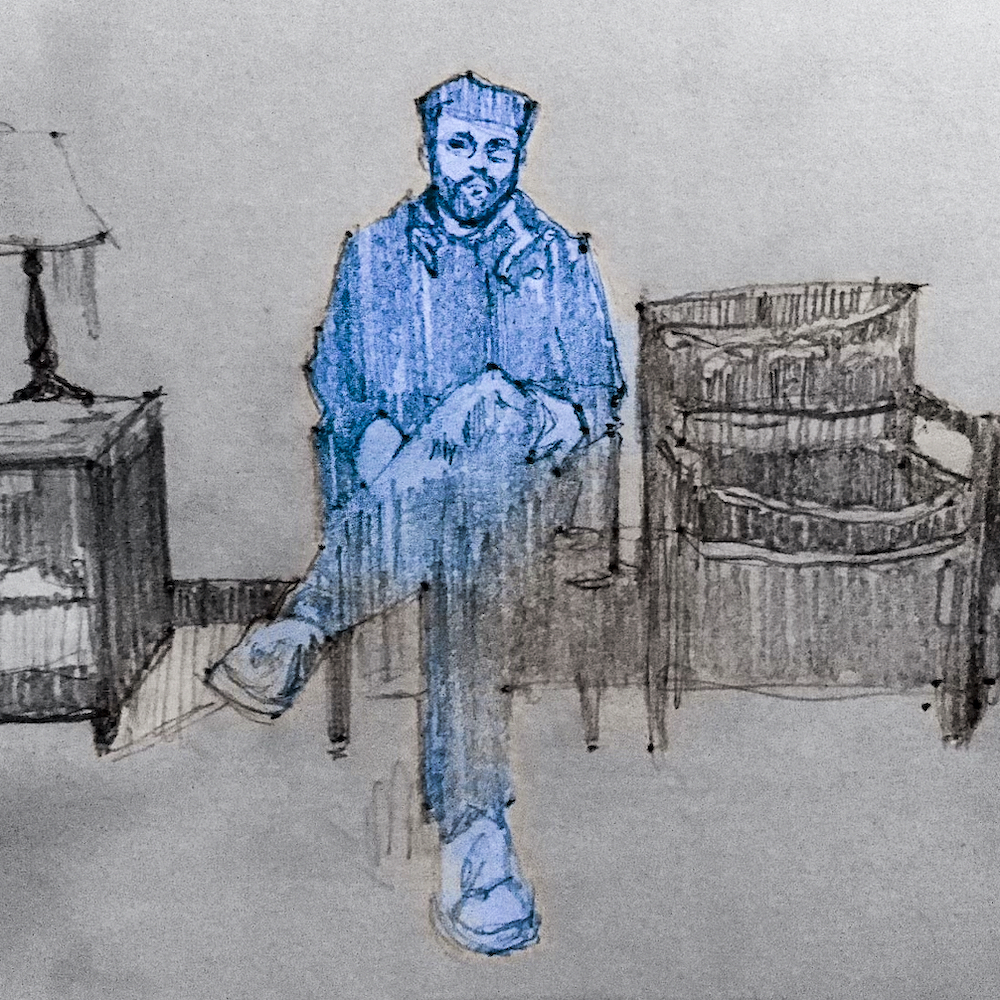
When Art Explains Art
by McKenzie Stubbert
For my album “Waiting Room,” I commissioned the painter Zachary Johnson to create the original cover art. It could have simply been a beautiful piece that, like many album covers, was incredibly vague. Instead, I got a portrait of myself that reflected back to me exactly what I had made: something far more autobiographic. Like a lot of music, my album drew inspiration from many places. But I never expected the album art to reveal to me what I had been trying to uncover.
This album took me seven years to complete. It began as a handful of unrelated pieces I slowly tinkered with, trying to find my so-called “voice.” I struggled to understand what I was making and what connected them to each other. Much of the music originated in film and other visual projects. I have been a full-time freelance composer for about fifteen years. Over the years, certain elements, moments, or, in some cases, entire works jumped out to me as rather personal and something I wanted to use for myself.
“Falling I-III” are cues from a short film. “Further” has its roots in my very first collaboration with the artist Chris Milk and his pioneering VR experience, “Evolution of Verse.” “Iésana” was composed for an already completed dance film directed and choreographed by Lily Skove. “Turn” began when, as a creative exercise, I re-scored a 1938 avant-garde animation by Oskar Fischinger.
I met Zach at a gallery showing his work in Hollywood back in 2017. I was immediately struck by his series, “Disappointed People Holding Onto Guardrails,” paintings with blurry aches and little lights poking out of the void. His sketches of “US” Magazine tabloid covers, with simple hand-drawn mis-replicas, acted as an x-ray of America, scraping off the thinnest membrane layer of our culture and revealing millions of screaming voices, desperate for love and acceptance. It deeply resonated with me. We struck up a friendship over many cups of coffee, and a few years later, I asked him to paint the cover for my album, which was then called “Respir,” named for the first piece I had finished.
Zach listened to the album, asked many questions, and suggested I send him pictures of the piano in my studio, perhaps one of me sitting in front. At the time, I was adamantly opposed to being on the cover. It’s not a pop album, and I’ve never cared about people knowing my face connected to my music. We agreed that he would paint the church that was across the street from my original studio in downtown Portland before I had relocated to Los Angeles. The image represented beliefs that still lingered when I began this project but had all but vanquished by the time I was done. Before he began, I thought, “It won’t be clear WHAT the album is about. It doesn’t need to be.” He insisted I send a snapshot of myself, just for inspiration. So, I snapped a photo of a photo my wife had taken. Me. Sitting alone in the waiting room of our marriage counselor’s office. Waiting to go in and talk about pain. Our families. Our struggles.
Several weeks later, he called me and said, “I’ve finished the church painting. I think it came out really well, and it will look great as your album cover.” It was melancholy and dreary and perfectly encapsulated what I wanted to project to the world.
“So….I know we talked about not putting an image of you on the cover, but I want you to see something.” He texted me a painting of the snapshot of me.
What I saw was an honest reflection of myself. A man sitting in a defensive position, trying to be calm, with the most important person in his life sitting across the room rather than in the chair next to him. Someone who thinks this “space” gives him power and “time to figure out who I am and what I want.”
I immediately changed the name of the album to “Waiting Room.”

I’m married to another artist (the writer-filmmaker Tiffany Kimmel), who was also working to find her own voice in her work as I worked on this album. We got married when she was young, and we were both naive, having grown up in a religion that encourages both of those things. When two voices are trying to emerge, they can both demand a lot of space. We tried our very best to encourage each other while, at other times, it felt like we couldn’t each truly find ourselves in the confines of marriage and cohabitation. Art-making is a very selfish pursuit. Every draft, every exciting new idea, every soon-to-be-understood-to-be bad idea is explored in a space with another very hungry, creative mind with thoughts, feelings, and opinions. Nothing can inspire you like a creative life partner. But, as the process can require an incredible amount of vulnerability, nothing can make you want to hide from yourself and the world more.
“Never I Know” is actually the instrumental version of a song whose lyrics we wrote together. It’s a duet for two voices struggling to be heard and understood. By each other. By the world. By themselves.
The greatest influence she had on this album was on the sound itself. I recorded demos of each piece with my very noisy home studio piano. I’ve spent years trying to digitally remove clicks, scrapes, and other “unwanted” business. I re-tracked the piano on a “proper” grand piano owned by my friend Patrick Warren in Studio City. When I edited everything together, I played the recordings for Tiffany. She listened thoughtfully, then said: “You kind of stripped the soul from this album.” So I returned to my 1949 Acrosonic, and instead of removing the clicks and the clinks, I turned them up.
Zach’s painting of me, from a photo taken by the person closest to me, contained everything from this seven-year journey. I felt like I had been in a waiting room. Waiting to finish this project. Waiting to find success in my career. Waiting for my partner and I to find each other.
Was I waiting to find my “voice” before feeling confident in what I was trying to say? Was I holding that empty chair open in fear that if someone were truly in that space, it wouldn’t be my “voice?” Tiffany and I were two artists living together, coming out of religion, trying to make art while surviving in an economy that doesn’t really support that. That waiting room was, I discovered, a self-imposed waiting room for me, a space I was waiting to emerge from.
I can be a very obtuse person. I make jokes as if I’m serious. “I’m joking most of the time,” I recently told a friend. “It sounds the same,” she lovingly scolded me. I sometimes try to keep a blank face lest I reveal something about myself that I’d prefer no one to know just yet. Some of this comes from feeling misunderstood for much of my life and not feeling like explaining myself. Some of it comes from being a creative person who wants to work in a space where people have to work a little to find meaning.
The original title of the album is a great example of my love of the obtuse. “Respir” sounds like a real word with multiple pronunciation possibilities, but it’s not. I used to revel in my own cleverness and think what was not obvious is, in fact, obvious. “Waiting Room” is not only a more direct idea, but, given the lyricless nature of the work, it provides a framework for the listener and deeply reflects the creation and meaning of the work.
The hard part was owning up to the “me” in the work. One of my greatest contradictions is my deep desire for privacy and my longing to be known. I love being anonymous, but I want to create work that is received by lots of people. I understand artists who want to hide behind monikers, costumes, and pageantry. There’s a beautiful freedom in that. But I had to acknowledge that one of the most important things to me is being honest with myself and with others.
Sometimes, we need art to reflect a truth we wouldn’t otherwise be able to see. “Waiting Room” was inspired by other work, which, in turn, inspired a piece of art that inspired me right back. What it was about had been in front of me the entire time, but I couldn’t see it until I saw Zach’s painting. It was like looking into a mirror that might have been invisible if it hadn’t been a work of art.
McKenzie Stubbert is an Emmy-nominated and AMP Award-winning composer based in Los Angeles. He has scored some of the pioneering and award-winning VR films for Chris Milk, Annapurna Pictures, Within, Here Be Dragons, and the UN. His album Waiting Room will be released on August 18, 2023.
Artwork by Zach Johnson.
Follow Vol. 1 Brooklyn on Twitter, Facebook, and sign up for our mailing list.
